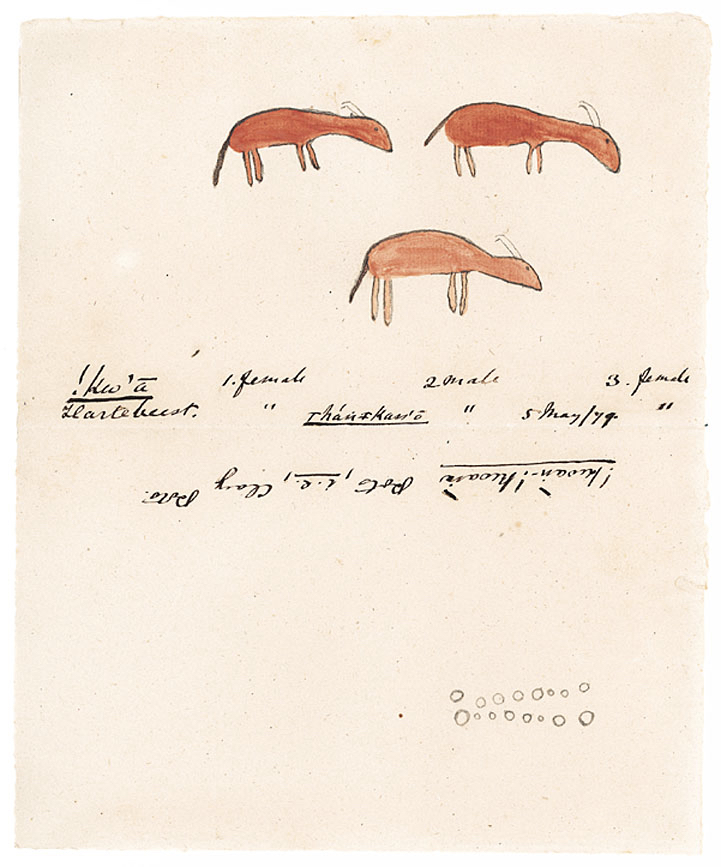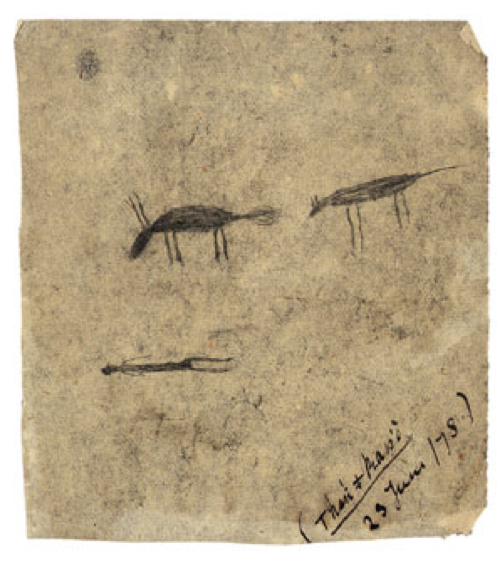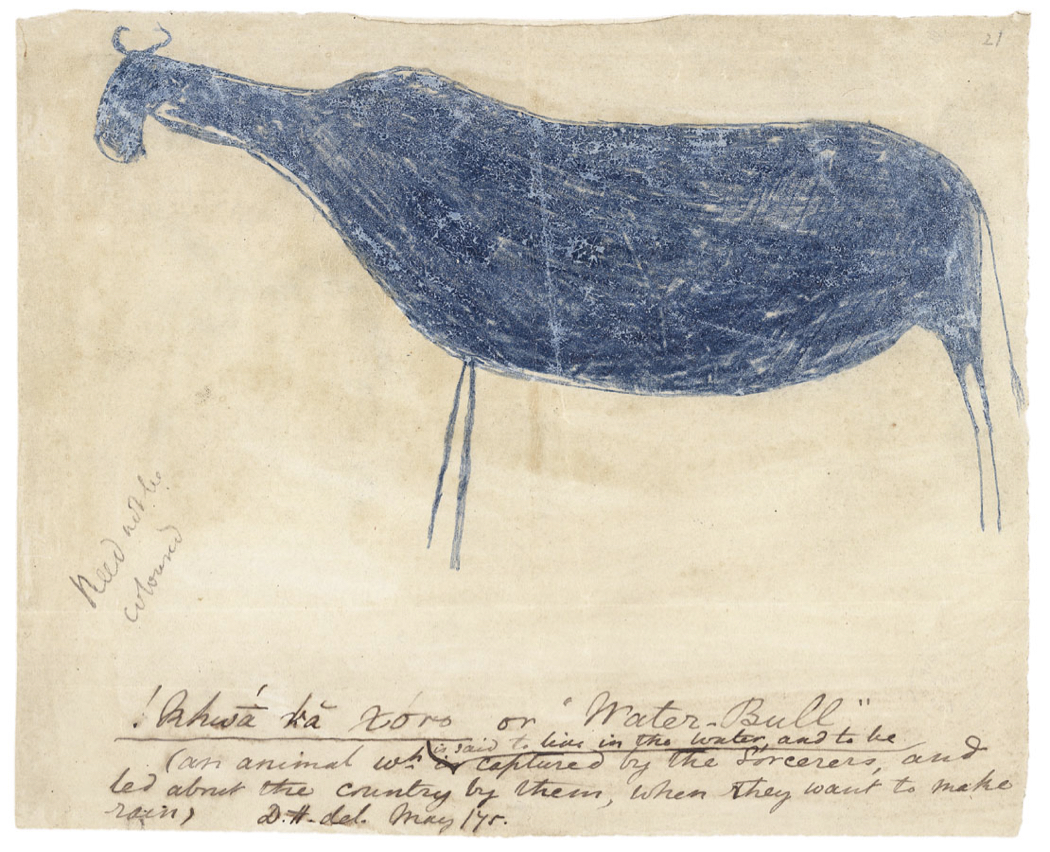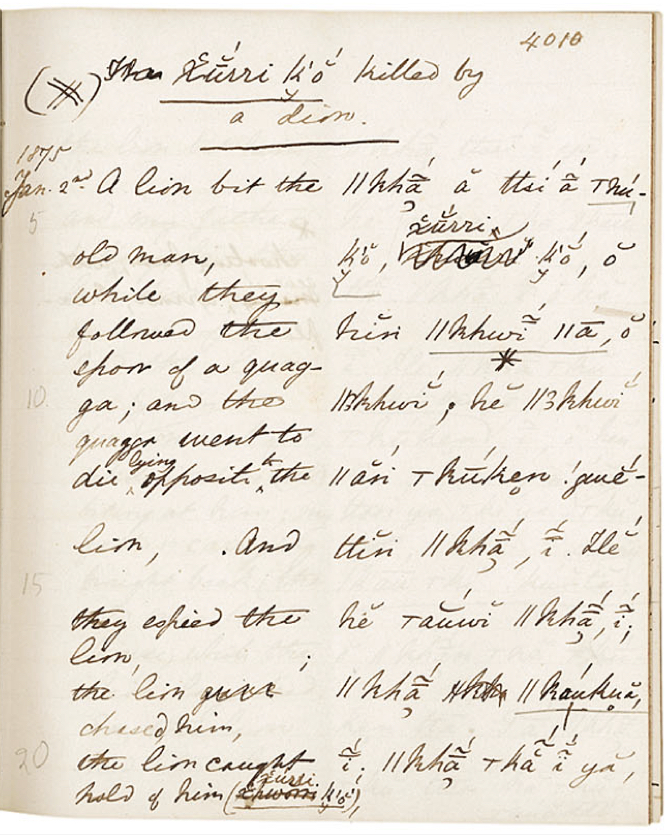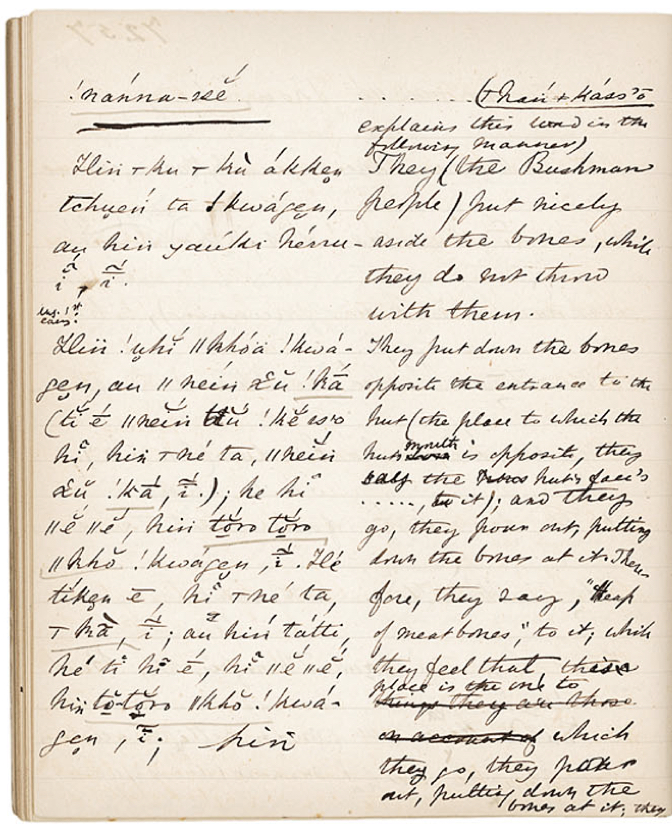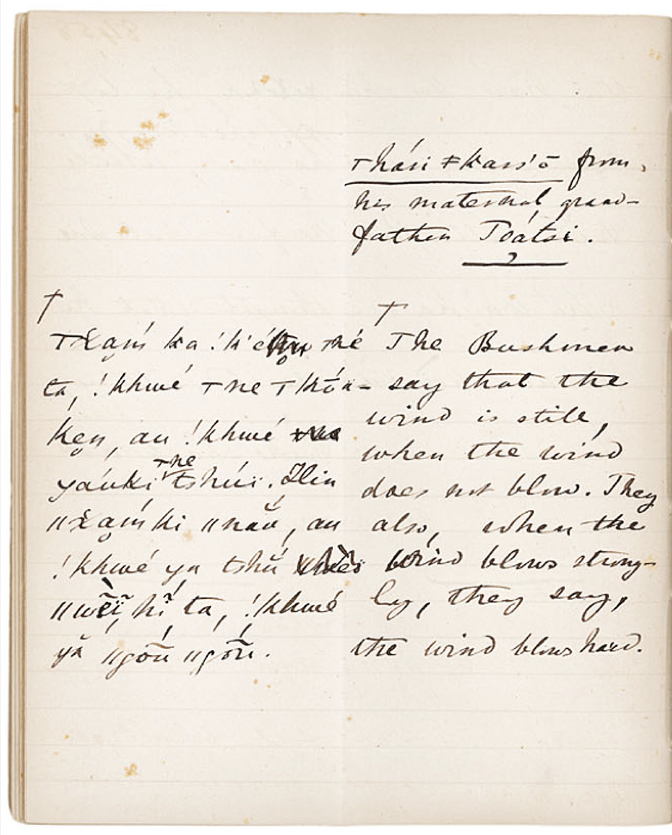‘The things which I must watch them, as (my) father thus spoke, he taught me about them; the things which I must watch them’
(Dia!kwain, LL55: 4398–9).
The |xam narratives transcribed by Lucy Lloyd describe a complex, strange and dynamic landscape that functions as a mythic character in its own right. A liminal space and colonial frontier, the veld described in the notebooks is also a site of potency and wonderment: an extra-dimensional realm where everything is charged with !gi (what Bleek and LLoyd translated as magic power). Here, the |xam encountered many people – and other beings – who were ‘different’. Many of these encounters resulted in the loss of their country and way of life. But in the 1870s, when |xam informants like |han≠kass’o, Dia!kwain, ||kabbo and !kweiten ta ||ken were telling their stories to Lucy Lloyd in Mowbray, there is no question that they considered Bushmanland the ‘Flat People’s country’. Despite the increasingly ever-present intrusion of strangers on their hunting ground, the narratives convey the |xam’s conviction of their ownership of the place they called |xam-ka !au.
The rock art of the San has often been identified as the primary expression of their spiritual and imaginative life. However, the activities of the |xam in their homeland, described to Bleek and Lloyd and written down in their notebooks, offer an equally rich source of insight into a thought-world governed by ritual and an immersion in altered states of consciousness. The |xam called their stories kukummi; in them the celestial bodies, the elements, the veld and the actions of people and animals were described as the ‘doings’ of the hunting ground.. These included the activities of the game and the ‘beasts of prey’ since the time of the First Bushmen or Early Race, hunting methods and observances, and customs and rituals relating to the common life of the |xam and the finding of food in the veld. Yet theirs was a common life that saw the magic potency of all living things and actions, even in the smoking of a feather over the fire or the shooting of an arrow.
A striking feature of Lloyd’s notebooks is that the physical presence of the hunting ground dominates the supernatural folklore as well as the more prosaic contributions – the mythic country of the First Bushmen is drawn with as much actuality as the Northern Cape Bushmanland veld. As such, the hunting ground described by the |xam contributors is both place and alternate dimension; all things and times are interconnected. The everyday is imbricated with the Early Times: the |xam’s mythical past, when the elements, celestial bodies and animals were all members of the Early Race and possessed their ‘thinking strings’. The world of the living also coincides with that of the dead: the |xam are surrounded by their ancestors and the spirit world. The contributors described the hunting ground as a place where ‘reality’ or temporal certainty was constantly interrupted by beings from another dimension. It seems from their narratives that even ordinary people regularly experienced these incursions of time and space.
On one level, the hunting ground narratives can be read as occurring in two broad categories – accounts of a more practical and everyday nature, such as those involving food, and those that are more obviously supernatural, describing the spirit world, Early Race, magical beliefs and the shamanistic practices of healers, rainmakers and sorcerers. However, real and pretend, history and myth, dreaming and wakefulness cannot be easily separated in the narratives, where even activities like eating ‘Bushman rice’ (ant eggs) are animated by preternatural description. Both metaphysical and more personal, practical contributions offer specific information about myriad plants and animals (most of them edible): their finding, hunting, catching, preparation and consumption, as well as a complex body of respect rituals called nanna‑sse. These actions include sharing and addressing the meat of dead animals and imitating their dying movements. The profusion of such details emphasises the |xam’s skill at exploiting the resources of their landscape, from the mythic First Bushmen to the Flat Bushmen.
Animals of every description populate the |xam landscape as individual characters and as creatures who are ‘different’. Even food animals exhibit magical properties and behaviours connected to the Early Race. For instance, the |xam hunters are described as being physically connected to the game and sharing bodily sensations. This connection originated in the early times, when the springbok were changed into people. The |xam are connected to the land and the elements in the same way they are connected to the game, and there are presentiments visible all around them – for instance, in the appearance of an unusual mist. In their blood and under their skin they are able to feel the coming of danger and bad weather, sense death and disaster and foretell the future. The |xam called these physical sensations or ‘tappings’ in the flesh !gwe, which Bleek and Lloyd also translated as ‘Bushman letters’.
Phenomenological descriptions of the hunting ground in the narratives further enhance their otherworldliness. Its characters, its flora and wildlife, the skies and the stretch of its horizon, the smells and the sounds of day and night; the celestial bodies, the features of the veld – from the weather to the kopjes and watersprings – are enriched by sensory narrative detail and Otherness. This is largely because the hunting ground is a mythologised landscape where all of the features of the veld personify the imaginative history of the |xam and the creation of their world. The trees are the youths of the Early Race changed in a thunderstorm, the reeds at the water-springs were once the arrows of the Early Race; flowers at the waterpit are dead maidens of the Early Race and the karosses, bows, mats, bags and belongings of their people are the plants and trees growing at its edges.
The |xam are always at the mercy of the elements, and in the notebooks the weather and other dramatis personae of the veld are characterised as temperamental and often menacing. The wind, for instance, is described as both beneficial and harmful. It gives the |xam presentiments of the coming of the rain, advancing game and encroaching danger. While the north wind is pleasant, bringing rain and good hunting, the west wind brings thirst and hunger. The east wind is angry and brings a great cold that shuts people inside their huts. The angry wind’s cries summon predators and bring threatening ‘jackal’ rain-clouds; its whirlwinds carry people off. There is a ‘killed things’ wind and a wind for the man ‘who kills things’. The west wind brings drought to the veld, and in times of desperate thirst the people must travel far away from their hunting ground to find food and water. On this journey they may be overcome by the sun, which ‘has really destroyed’ and caused people to faint, ‘killing them’ (|han≠kass’o, LL92: 7522–7526).
Of all the ‘Great Things’ on the hunting ground, rain is perhaps the most powerful.
Along with celestial bodies like the Moon, Sun and Stars and elements like the Wind, all of which have names, the Rain is a powerful entity called !khwaa. Rainmaking is reserved for powerful sorcerers (called !giten). Its animals or ‘meat’ – like the puff adder, frog, porcupine, water tortoise, rain bull and swallow – are feared and respected by the |xam. Its ‘places’ like waterholes are sites of presentiment, bewitchment and transformation and are an entrance to the spirit world. Waterholes belonged to the |xam and were passed down through generations, but the hammerkop bird could see presentiments of their deaths beneath the water’s surface. Rainclouds are associated with death: the |xam are said to resemble rainclouds when they die, and the person who dies is called the ‘person who rains’ (|han≠kass’o, LL103: 8465). The rain also causes death: when angry, it ‘fights’ and kills people in the form of hail, lightning or poisonous snakes. This dualism is typical of the hunting ground narratives, and the threat present in many narratives goes hand in hand with lessons about caution and vigilance.
The theme of ‘understanding’, or possessing one’s thinking strings, appears throughout the |xam narratives, usually in stories of mythical characters like ||kaggen, who would often act ‘foolishly’, with disastrous repercussions. The Early Race narratives account for the actions of everything in the |xam universe, and |xam children were taught ‘a great story’ so they can ‘feed themselves’ (Dia!kwain, LL55: 4404). One such great story is the Anteater’s laws, given in the form of its curse, which regulate the |xam universe. Everything in the landscape of the Early Race had a name, which they knew when to speak and when not to. Through a complex system of rituals, actions, observances and avoidances, the |xam were able to maintain a fragile balance with an often-hazardous environment by teaching and following these laws. The stakes are made clear throughout the narratives: the man who shoots ‘well’ lives, while the man who shoots ‘amiss’ dies of hunger (||kabbo, LL18: 1176v); dying of starvation is ‘when we shoot our death, when we are going to be ill’ (|han≠kass’o, LL89: 7263v).
Many hunting ground narratives describe the actions of !giten and the presence of the spirit world, emphasising the fact that the |xam contributors were knowledgeable about the doings of supernatural beings in addition to more practical concerns. These narratives include descriptions of sorcerers and their shamanistic activities – whether they are dreaming, healing possessed people by ‘snoring’ them, ‘working’ with ‘great things’ like the rain or working the game. Sorcerers are clearly beneficial to the |xam but are also capable of great harm, especially if they are dead. Angry dead sorcerers may carry people away, eat human corpses, shoot ‘handsome’ people with sickness and ‘own the bodies’ of nocturnal creatures – usually to hurt people who have not displayed understanding.
Dead game-sorcerers are called |nu-!k’e, and their ‘sorcery’s doings seemed like a person who always lives’, Dia!kwain told Lloyd (LL60: 4801v). To ensure successful hunting and a good relationship with the |nu-!k’e , it is important to address them respectfully. Dia!kwain explained how his mother and the other women beat their digging-stick stones on the ground while praying to the |nu-!k’e, who, if displeased, ‘will sit with their backs towards us’, resulting in the failure of the hunt and starvation (LL60: 4802, 4816v).
Angry |nu-!k’e possess the game, and these bewitched animals are described as being particularly dangerous. Possessed springbok could refuse to lie down and die when shot; they could make the hunters ill by firing invisible sticks at them or could lead them straight to waiting beasts of prey. Lions, for instance, are believed to be sorcerers in disguise who venture out on magical expeditions to attack the |xam at night, throwing lion-ear-shaped shadows that foretell danger.
Yet other, less harmful apparitions of various kinds – like spirit people and spirit animals such as antelope – also appear to the living in the veld, often in mirages or atmospheric conditions of mist and dust. These spirit people are the |xam’s ancestors, linked to the living through the ‘part’ of themselves left behind; the part ‘with which he still thinks of us’ (Dia!kwain, LL72: 5822v).
The |xam contributors’ longing for their country and their families resonates throughout the notebooks. The many allusions to death and loss in the narratives testify to the experience of the |xam on the 19th century frontier and describe a landscape of trauma. For the |xam, the hunting ground became the site of the dispossession and eventual annihilation of their people. By the early 20th century, Bleek and Lloyd’s notebooks contained the few surviving traces of the Flat Bushmen’s world, along with a collection of their drawings, paintings and other artefacts collected and recorded before the |xam left Mowbray to return to |xam-ka !au.
Curated narratives:
Xurri ko killed by a lion by !kweiten ta ||ken (Rachel) (VI)
2 January 1875 (started)
!kweiten ta ||ken’s father and a man called Xurri ko were out hunting quagga when a lion caught Xurri ko and bit him in the leg. Xurri ko died from the severity of his wounds.
!nanna-sse by |han≠kass’o
1 August 1878 (started)
|han≠kass’o’s explanation of the term !nanna-sse. People put bones in a heap in a number of places. Different people take their finished bones and put them in the same place. Much is done opposite the house of the man who shot the springbok. These practices ensure that the man who shoots springbok will not miss on the hunting-ground when next he hunts.
Wind and stars by |han≠kass’o
1–2 June 1879
After the wind has blown and dies, the place becomes warm from the sunshine. The wind becomes cold when a man kills an animal (the killed thing’s wind) and the people say that his wind is cold. When it is hot the wind is gentle and not strong.
Rain protects frogs by |han≠kass’o (Klein Jantje) (VIII)
14 September 1878 (started)
If people kill frogs, rain will not fall and drought will come. The people will have to eat gambro plants because other plants have disappeared.
About sorcerers: their death, their snoring work, earthquakes and the rain by Dia!kwain (David Hoesar) (V)
11 November 1875 (started)
Sorcerers’ hearts sound like the rain when they die, and their hearts fall into waterpits. Parents say they fear falling stars, because they know things that happen and they always fall for a reason. Sorcerers can send their sorcery to different places to ‘spirit’ people away or kill them.
What ||kabbo said about his intended return home to Bushmanland by ||kabbo (Jantje) (II)
23 July–2 August 1873 (finished on or about)
‘||kábbo’s intended return home. He awaits the Moon that he may return, and hear the Bushman stories. Here he works woman’s work, while his comrades at home hear histories that travel; but he does not visit, as they do. The people down here do not talk his language; they visit their like, and are work-people who keep houses in order, and plant food. The Flat Bushmen visit and smoke at each other’s houses, and listen to histories. On his return to Bushmanland, he intends to put his former house in order, and reassemble his children. He inherited his place, and brought his wife to it (L II.-32. 2874-2925 rev.).’ [from ‘Specimens’]

Eustacia Riley is a visual historian specialising in South African landscape representation. She received her BA(FA), HDE (Higher Diploma in Education), MFA and PhD from the University of Cape Town. For several years she worked as a research officer at Llarec (the Lucy Lloyd Archive, Resource and Exhibition Centre), now part of the Centre for Curating the Archive, a University of Cape Town research centre directed by Pippa Skotnes and located at the Michaelis School of Fine Art. In this capacity she helped digitise the Lloyd-Bleek archive of |xam folklore and the George Stow collection and published a chapter on landscape in the narratives of the |xam in “Claim to The Country: The Archive of Lucy Lloyd and Wilhelm Bleek” by Pippa Skotnes (2007). She has taught several visual history courses at San Diego State University’s School of Art and Design.
